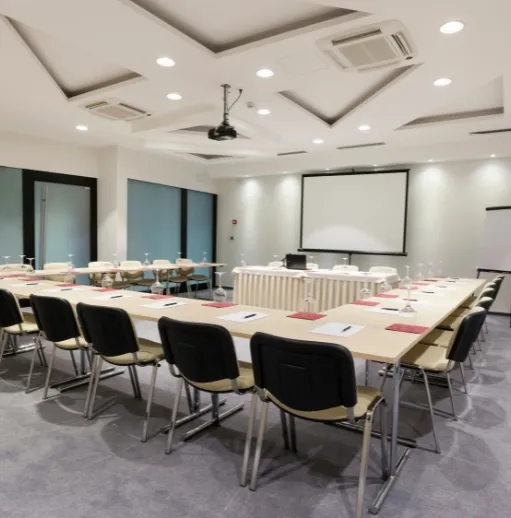
Conference room scheduling software helps you make the most of your space, boosting utilization numbers to deliver a better return on real estate investments. By removing unattended reservations and the confusion of double bookings, employees enjoy a streamlined process that helps them find and use the spaces they need to connect and collaborate with coworkers.
What are the benefits of conference room scheduling software?
The right software solution creates transparency that helps you improve operational efficiency and the employee experience.
Match meetings to conference room capacity
With video conferencing, you never have to worry about how many people you invite to the meeting. There’s always a bit more space on the screen for one more person. For in-person meetings, numbers matter a lot more.
With meeting room scheduling software, you can set comfortable capacity limits and display them on the room scheduling panels outside each room. Employees can easily see how many people each room can accommodate and choose the one that’s most conducive to their gathering. Managers don’t have to worry about scheduling that big monthly meeting in a room that’s too small, and smaller groups of team members can book the rooms that better match their dynamics.
Avoid the confusion of double-booking
It’s frustrating to book a room through your calendaring app only to realize later that someone else has already reserved it. Unfortunately, this is a common problem if you only use basic calendaring systems or free conference room scheduling tools. The best conference room scheduling systems remove the source of this frustration, so employees don’t have to argue over who gets to use the room they both reserved.
Double-booking is often the single most important reason companies invest in conference room scheduling software. It saves not only time but also helps you avoid what can be uncomfortable conversations between coworkers.
Remove unattended reservations
Unattended meeting reservations happen for many reasons. Someone reserves a room and then cancels the meeting at the last minute. Or they scheduled a recurring meeting every week for a year and the room is still showing as reserved for months after a change in priorities changes the schedule. These “ghost” and “zombie” meetings keep your conference rooms from being used by people who need them, wasting valuable space and resources while contributing to a frustrating workplace experience. No one wants to walk past the empty boardroom they tried to schedule.
Meeting room scheduling technology eliminates most unattended reservations by requiring employees to check in. If no one checks into the room they’ve reserved after a certain period, the system will automatically make the conference room available again. It’s also possible for the system to check sensor data. If there’s still no one in the room 10 minutes after the meeting was supposed to start, the space goes back to “available” in the system.
Boost employee productivity
As more employees move to the hybrid work model, they need to put more planning into the how, when, and where of working directly with coworkers. If you’re only in the office three days a week, you don’t want to spend the first 15 minutes of a planned team brainstorming session searching for collaboration space. When employees can clearly see which conference rooms are available and book them within seconds, they can make the most of their time in the office.
What do the best conference room scheduling solutions have in common?
Unfortunately, not all meeting room scheduling systems offer the same features. Some aren’t much better than calendar apps. Others are difficult to implement or don’t integrate with the technology employees already use, which makes it easy for employees to bypass them. For the biggest return on your investment in conference room booking software, make sure you’re getting the right feature set.
Easy to use
It’s not rocket science — it’s conference room scheduling software. An innovative solution should be more high-tech than a piece of paper and tape, but it shouldn’t be more difficult to learn or use than your other office applications. Employees should be able to see which conference rooms are available and reserve them in seconds. Although the learning curve should be minimal, software that provides resources for administrators and employees can help improve user adoption rates.
Mobile
With the hybrid work model and flexible offices, employees need to access reservation systems from a variety of locations. That’s why mobile conference room booking and desk reservations are so important in the modern workplace. If you’re checking your email in the morning from the home office and see a confirmation for a meeting time that afternoon when you’re going to be onsite, it’s much easier to reserve the room right then and there.
Employees should be able to search for open conference rooms on their smartphone and quickly schedule meetings based on their needs. They should be able to see each room’s capacity, equipment, and amenities, too.
Compatible with existing calendar applications
Employees shouldn’t have to learn or jump to a new calendar application to book meeting rooms. Transferring contact information, emails, and calendar appointments from one application to another is a time-consuming and error-prone process. To avoid mistakes and save time, conference room scheduling software should integrate with your existing calendar applications.
Runs in real-time
Real-time updates are critical for fast-paced workplaces. Meeting room scheduling software won’t do anyone any good if there is a lag in performance. Employees don’t need to know what the schedule was two days ago. They need to know right now.
If a meeting is canceled, conference room scheduling displays and calendar appointments should be updated simultaneously to avoid scheduling conflicts. After all, your business runs in real time. So should your room scheduling software.
Provides workplace analytics for planning and budgeting
Meeting room scheduling software is much more useful when it provides insight into how to use your meeting room more effectively. It should capture important workplace analytics, including:
- Average meeting length
- Average meeting size
- Number of scheduled vs. impromptu meetings
- Number of meeting cancellations
- True conference room utilization
An innovative meeting room scheduling solution can help you learn more about your organization’s meeting habits and what types of resources and technologies employees use most often. When planning your annual budget, you’ll have a better idea of where your money can best be spent.
Integrates with wayfinding software and digital displays
Gone are the days of taping a “RESERVED” sign to the door of your conference room — or at least they should be. When shopping for a modern room reservation solution, look for room scheduling software that incorporates a professional digital display to hang outside your meeting rooms.
Digital displays can provide a daily itinerary for the room, indicate when a meeting is in progress, and allow for automatic updating if an event is rescheduled or canceled. Using these displays can help you eliminate uncertainty, stay organized, and maximize time when employees are scheduling or attending meetings. They can even be designed to support your company’s brand. You already use customizations in your personal technology.
To help employees navigate the new environment, consider a solution that also integrates with wayfinding signage. That way, employees can easily see where each room is located, even if the names have changed or they’re new to the office. You can also use your digital signage to share important announcements and reminders.
While face-to-face meetings are one of the most effective ways to collaborate, it’s not always easy to achieve when you’re juggling multiple schedules, conference rooms, and tech resources. Simplify your company’s resource management by selecting a conference room scheduling software solution that streamlines productivity, reduces scheduling conflicts, and provides valuable insight that helps you with space planning and real estate portfolio management.




